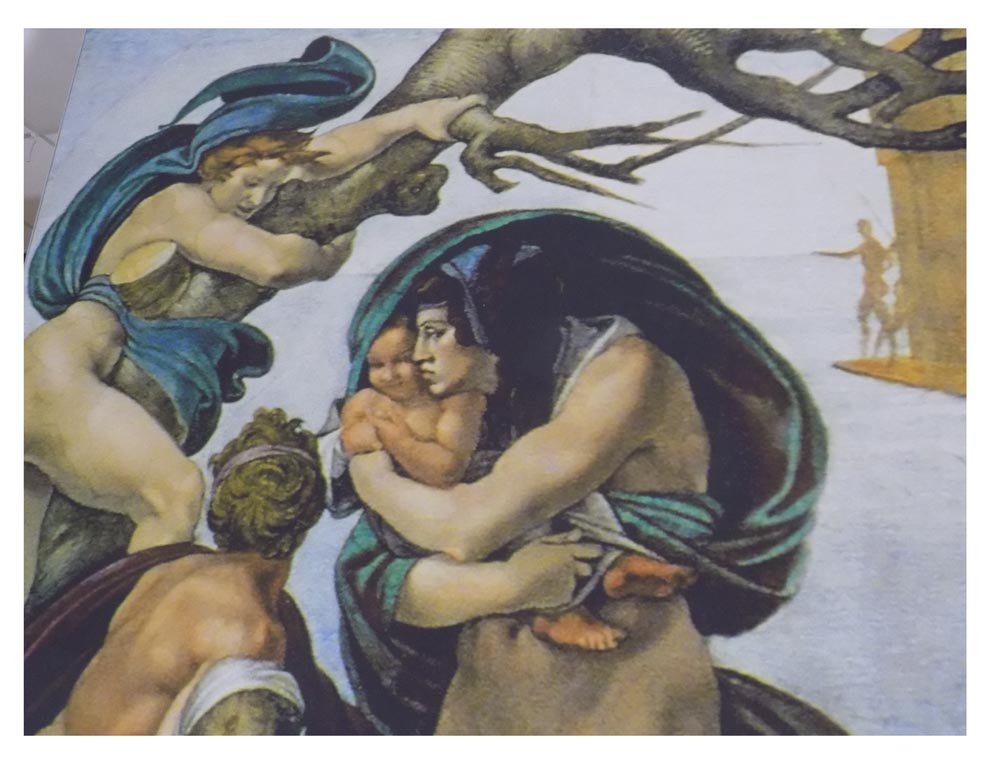

In May of this year the grand exhibit of the Sistine Chapel came to Oak Brook. It was astonishing. Remarkable. Beautiful. Extraordinary.
Completed in 1512 and restored in the 1980s, these heavy canvas reproductions took two years to complete with the help of the Vatican photographer. And to think our eyes are seeing frescoes created by Michelangelo more than 500 years previously.
Soft Gregorian chant was playing in the background. I was told the exhibit was sold out for the first four weeks and only an attendance of 125 was permitted to view it each day due to COVID. I loved every single second spent there and did not want to leave.
But I took enough photographs that I can use those imagers now to make my own cards for friends. I can recall those happy moments in an instant whenever I want to visualize immense beauty.
Michelangelo di Lodovico Buonarroti Simoni was born March 6, 1475 and died at age 88, February 18, 1564 in Rome. In his lifetime he often was called Il Divino (the Divine One). His work was prodigious in sculpture, painting and architecture. He was a poet of the High Renaissance. Some scholars have described him as the greatest artist of his age and even as the greatest artist of all time.
His Pieta and David sculptures were completed before he turned 30. He created two of the most influential frescoes in the history of Western art: The scene from Genesis on the ceiling of the Sistine Chapel in Rome and the Last Judgment on its altar wall.
When I was in Rome, I visited the Sistine Chapel. That Roman day was blistering hot and the Chapel was shoulder to shoulder humanity. So enjoying the ceiling was hardly an option. I walked through quickly and bought a rosary at the small shop run by nuns just outside the Chapel. I bought bottled water from street vendors, bottle after bottle, just to stay hydrated.
The Sistine Chapel has great symbolic meaning for the papacy as the chief consecrated space in the Vatican and is used for great ceremonies such as electing and inaugurating new popes.
The Twelve Apostles was planned as the theme. Michelangelo produced 12 large figures of which seven were prophet and five were sibyls, or female prophets, found in Classical myths. He filled the central spine of the long curved surface with nine scenes from Genesis.
Three of them depicted the Creation of the World, three were the stories of Adam and Eve and three were the stories of Noah. Below the prophets and sibyls, were small figures of the 40 generations of Christ’s ancestors, starting with Abraham.
This masterpiece was completed in less than four years. There was an interruption in the year 1510-1511 when no payment was made. Commissioned by Pope Julius II, Michelangelo, because he was a famous and respected artist, was paid 3,000 ducats which would be $78,000 in today’s money. A staggering amount of money to be sure! The ceiling stretches more than 500 square metres of space and contains more than 300 figures.
The Biblical creation narrative from the Book of Genesis in which God gives life to Adam, the first man, is part of the fresco complex iconographic scheme and is chronologically the fourth in the series of panels depicting episodes from Genesis. God is depicted as an elderly white-bearded man wrapped in a swirling cloak while Adam, is completely naked. God’s right arm is outstretched to impart the spark of life from his own finger into that of Adam. This is a reminder that man is created in the image and likeness of God. (Gen.1-26).
And so on this small, blue-marbled, planet, in a vast galaxy, in a immense darkness and showered with millions of stars, we see today and appreciate Michelangelo’s brilliance left to all humanity for all ages.

